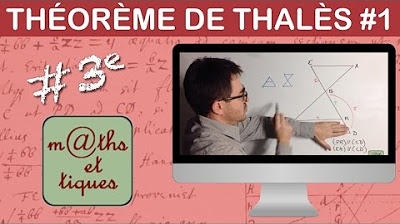Teorema de TALES | Prof. Gis/
Summary
TLDRIn this lesson on Thales' Theorem, the script explores the mathematician's contributions to geometry, particularly his theorem about parallel lines and proportional segments. The video explains how Thales' theorem applies in real-life situations, such as determining distances in land measurements and designing a shelf. It demonstrates the importance of ratio and proportion to solve problems by setting up proportional equations, with relatable examples like measuring a property with a lake or calculating shelf dimensions. The lesson is engaging, educational, and practical, showing how Thales' theorem remains relevant in everyday scenarios.
Takeaways
- 😀 Thales of Miletus was an ancient mathematician, philosopher, astronomer, and merchant who contributed significantly to mathematics around 625 BC.
- 😀 Thales is known as the 'Father of Descriptive Geometry' and made advancements in ratio and proportion calculations that are still used today.
- 😀 Thales' Theorem states that if a set of parallel lines is cut by two transversal lines, the segments formed on both sides of the transversals are proportional.
- 😀 A 'bundle of parallel lines' refers to a set of parallel lines that are cut by two transversal lines, forming proportional segments at their intersections.
- 😀 The relationships between angles, such as alternate internal angles and corresponding angles, can also be observed in the geometric setup of Thales' Theorem.
- 😀 Thales' Theorem can be applied to real-life situations like land measurement, where you can calculate distances across obstacles like lakes using proportionality.
- 😀 Proportions are central to Thales' Theorem, and students are encouraged to use cross-multiplication to solve problems involving proportional segments.
- 😀 In the land measurement example, the distance across the lake is calculated by setting up a proportion based on known segment lengths.
- 😀 The theorem also applies to construction scenarios, such as determining the size of segments in building projects like shelves, where proportionality between segments is key.
- 😀 The speaker emphasizes understanding ratio and proportion concepts and their application in solving geometry problems involving proportional segments.
- 😀 The speaker encourages viewers to engage with additional classes on angles, ratios, and more complex examples of Thales' Theorem in future lessons.
Q & A
Who was Thales of Miletus?
-Thales of Miletus was a mathematician, astronomer, philosopher, and merchant from ancient times, approximately 625 years before Christ. He is considered the father of descriptive geometry and contributed to advancements in ratio and proportion calculations.
What is Thales' Theorem?
-Thales' Theorem states that if a set of parallel lines is cut by two transversal lines, the segments formed on the transversals are proportional. This means the ratios of the lengths of the segments on one transversal are equal to the ratios of the segments on the other transversal.
What is meant by a 'bundle of parallel lines' in Thales' Theorem?
-A 'bundle of parallel lines' refers to a set of multiple parallel lines that are cut by two transversal lines, forming proportional segments at the intersections.
How does Thales' Theorem relate to proportionality?
-Thales' Theorem involves proportionality by stating that the segments formed by the parallel lines and the transversals are proportional to each other. For example, the ratio of one segment on one transversal is equal to the ratio of the corresponding segment on the other transversal.
What kind of angles are formed when parallel lines are cut by transversal lines?
-When parallel lines are cut by transversal lines, various types of angles are formed, including alternate interior angles, corresponding angles, and angles opposite the vertex. These angles help define the relationships between the parallel lines and transversals.
How can Thales' Theorem be applied in real-life situations?
-Thales' Theorem can be applied in real-life situations, such as calculating distances that are difficult to measure directly, like the distance across a lake. By using proportionality, one can determine distances or sizes in scenarios where direct measurement is not possible.
In the land-buying example, how was Thales' Theorem used to calculate the distance?
-In the land-buying example, Thales' Theorem was used to find the distance across a lake by setting up a proportion between the known segments (such as the lengths of lots) and unknown segments (like the distance across the lake). By applying the ratios, the unknown distance was calculated.
What role does ratio and proportion play in solving problems related to Thales' Theorem?
-Ratio and proportion are central to solving problems involving Thales' Theorem, as the theorem defines proportional relationships between segments formed by parallel lines and transversals. This allows one to set up and solve proportional equations to find unknown lengths.
What is the significance of cross-multiplication in solving Thales' Theorem problems?
-Cross-multiplication is a key method for solving proportional equations that arise from Thales' Theorem. By cross-multiplying the terms in the proportion, you can isolate and solve for the unknown variable in the equation.
How can Thales' Theorem be used to solve a real-world construction problem, such as building a shelf?
-In a construction scenario, such as building a shelf, Thales' Theorem can be applied to calculate dimensions based on proportional relationships. For example, using known measurements of one segment of the shelf, you can apply proportionality to calculate unknown dimensions, like the height or length of other parts.
Outlines

This section is available to paid users only. Please upgrade to access this part.
Upgrade NowMindmap

This section is available to paid users only. Please upgrade to access this part.
Upgrade NowKeywords

This section is available to paid users only. Please upgrade to access this part.
Upgrade NowHighlights

This section is available to paid users only. Please upgrade to access this part.
Upgrade NowTranscripts

This section is available to paid users only. Please upgrade to access this part.
Upgrade Now5.0 / 5 (0 votes)





